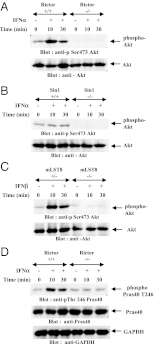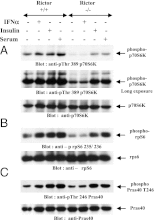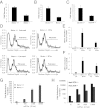Regulatory effects of mTORC2 complexes in type I IFN signaling and in the generation of IFN responses
- PMID: 22550181
- PMCID: PMC3356630
- DOI: 10.1073/pnas.1118122109
Regulatory effects of mTORC2 complexes in type I IFN signaling and in the generation of IFN responses
Abstract
IFNs transduce signals by binding to cell surface receptors and activating cellular pathways and regulatory networks that control transcription of IFN-stimulated genes (ISGs) and mRNA translation, leading to generation of protein products that mediate biological responses. Previous studies have shown that type I IFN receptor-engaged pathways downstream of AKT and mammalian target of rapamycin complex (mTORC) 1 play important roles in mRNA translation of ISGs and the generation of IFN responses, but the roles of mTORC2 complexes in IFN signaling are unknown. We provide evidence that mTORC2 complexes control IFN-induced phosphorylation of AKT on serine 473 and their function is ultimately required for IFN-dependent gene transcription via interferon-stimulated response elements. We also demonstrate that such complexes exhibit regulatory effects on other IFN-dependent mammalian target of rapamycin-mediated signaling events, likely via engagement of the AKT/mTORC1 axis, including IFN-induced phosphorylation of S6 kinase and its effector rpS6, as well as phosphorylation of the translational repressor 4E-binding protein 1. We also show that induction of ISG protein expression and the generation of antiviral responses are defective in Rictor and mLST8-KO cells. Together, our data provide evidence for unique functions of mTORC2 complexes in the induction of type I IFN responses and suggest a critical role for mTORC2-mediated signals in IFN signaling.
Conflict of interest statement
Conflict of interest statement: D.P.B. is an employee of Biogen Idec and an owner of Biogen Idec stock.
Figures





Similar articles
-
PRR5, a novel component of mTOR complex 2, regulates platelet-derived growth factor receptor beta expression and signaling.J Biol Chem. 2007 Aug 31;282(35):25604-12. doi: 10.1074/jbc.M704343200. Epub 2007 Jun 28. J Biol Chem. 2007. PMID: 17599906
-
Receptor-recognized α₂-macroglobulin binds to cell surface-associated GRP78 and activates mTORC1 and mTORC2 signaling in prostate cancer cells.PLoS One. 2012;7(12):e51735. doi: 10.1371/journal.pone.0051735. Epub 2012 Dec 14. PLoS One. 2012. Retraction in: PLoS One. 2025 Jun 5;20(6):e0325675. doi: 10.1371/journal.pone.0325675. PMID: 23272152 Free PMC article. Retracted.
-
Interferon γ (IFNγ) Signaling via Mechanistic Target of Rapamycin Complex 2 (mTORC2) and Regulatory Effects in the Generation of Type II Interferon Biological Responses.J Biol Chem. 2016 Jan 29;291(5):2389-96. doi: 10.1074/jbc.M115.664995. Epub 2015 Dec 8. J Biol Chem. 2016. PMID: 26645692 Free PMC article.
-
Regulation of insulin receptor substrate-1 by mTORC2 (mammalian target of rapamycin complex 2).Biochem Soc Trans. 2013 Aug;41(4):896-901. doi: 10.1042/BST20130018. Biochem Soc Trans. 2013. PMID: 23863152 Free PMC article. Review.
-
Targeted Inhibition of Rictor/mTORC2 in Cancer Treatment: A New Era after Rapamycin.Curr Cancer Drug Targets. 2016;16(4):288-304. doi: 10.2174/1568009616666151113120830. Curr Cancer Drug Targets. 2016. PMID: 26563881 Review.
Cited by
-
Viral Infections and Interferons in the Development of Obesity.Biomolecules. 2019 Nov 12;9(11):726. doi: 10.3390/biom9110726. Biomolecules. 2019. PMID: 31726661 Free PMC article. Review.
-
Deficiency in either 4E-BP1 or 4E-BP2 augments innate antiviral immune responses.PLoS One. 2014 Dec 22;9(12):e114854. doi: 10.1371/journal.pone.0114854. eCollection 2014. PLoS One. 2014. PMID: 25531441 Free PMC article.
-
IFN-β-specific signaling via a unique IFNAR1 interaction.Nat Immunol. 2013 Sep;14(9):884-5. doi: 10.1038/ni.2686. Nat Immunol. 2013. PMID: 23959176 No abstract available.
-
Beyond autophagy: New roles for ULK1 in immune signaling and interferon responses.Cytokine Growth Factor Rev. 2016 Jun;29:17-22. doi: 10.1016/j.cytogfr.2016.03.008. Epub 2016 Apr 1. Cytokine Growth Factor Rev. 2016. PMID: 27068414 Free PMC article. Review.
-
Critical roles for Rictor/Sin1 complexes in interferon-dependent gene transcription and generation of antiproliferative responses.J Biol Chem. 2014 Mar 7;289(10):6581-6591. doi: 10.1074/jbc.M113.537852. Epub 2014 Jan 27. J Biol Chem. 2014. PMID: 24469448 Free PMC article.
References
-
- Stark GR, Kerr IM, Williams BR, Silverman RH, Schreiber RD. How cells respond to interferons. Annu Rev Biochem. 1998;67:227–264. - PubMed
-
- Darnell JE, Jr, Kerr IM, Stark GR. Jak-STAT pathways and transcriptional activation in response to IFNs and other extracellular signaling proteins. Science. 1994;264:1415–1421. - PubMed
-
- Parmar S, Platanias LC. Interferons: Mechanisms of action and clinical applications. Curr Opin Oncol. 2003;15:431–439. - PubMed
-
- Javed A, Reder AT. Therapeutic role of beta-interferons in multiple sclerosis. Pharmacol Ther. 2006;110:35–56. - PubMed
-
- Darnell JE., Jr STATs and gene regulation. Science. 1997;277:1630–1635. - PubMed
Publication types
MeSH terms
Substances
Grants and funding
LinkOut - more resources
Full Text Sources
Other Literature Sources
Molecular Biology Databases
Research Materials
Miscellaneous

